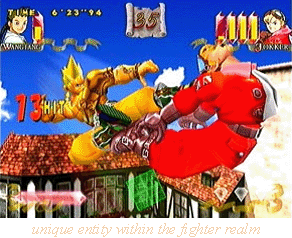I have played my share of 3D and 2D fighting games in my gaming career, and most of them have only a few little quirks that set them apart from each other. Power Stone is its own unique entity within the fighting game realm. It’s not the first true 3D game, but it is the first to use its environment for more than just pushing your opponent for a Ring-Out. Interacting with and using each given level is vital; it adds a sort of realism amongst the cartoon-like atmosphere. This is what sets Power Stone apart from the other fighters.
The story is just as watered down as most fighting games’, always being just enough to loosely tie things together and give you a reason to fight. Basically, eight different characters, plus two more that are unlockable, from all walks of life are searching for the fabled Power Stone. The Power Stone has the ability to grant any wish to its owner (it’s very original…). You’ll find out everyone’s specific motive after you beat the game with each character.
The characters are as varied in design as they are in playing style. You can always find someone to fit your playing style. For example, the main character, Falcon, is your average all-around fighter with  medium strength and speed. Then you have your speed-demon girl named Ayame who has weak hits but can easily dodge most attacks thrown at her. And there’s your hulk-like character, Gunrock, with powerful attacks that can take down any life-bar quickly, but is slow as molasses. The character design is decent as well. You have an Arabian genie girl by the name of Rouge, a psychotic knife-wielding clown named Jack, and even a pirate captain missing a crew who goes by the name Kraken.
medium strength and speed. Then you have your speed-demon girl named Ayame who has weak hits but can easily dodge most attacks thrown at her. And there’s your hulk-like character, Gunrock, with powerful attacks that can take down any life-bar quickly, but is slow as molasses. The character design is decent as well. You have an Arabian genie girl by the name of Rouge, a psychotic knife-wielding clown named Jack, and even a pirate captain missing a crew who goes by the name Kraken.
When I think of Power Stone‘s gameplay, I think of Fighting Force in a one-on-one setting. What I mean by this is that you can pick up tons of things in the environment and use them to hurt your opponent. There are your normal pick-ups like guns, bombs, swords, etc. and there are normal scenery–type items like chairs, boxes, pots, and whatever else is lying around. Another key part about using the environment is the level itself. You can jump and push off of the walls for a crazy combo, hang from the ceiling to crush your adversary on the way down, and even swing off of pillars to give your opponents a flying kick!
Then you have the stones. Basically, every level has three stones to get, and you and your opponent each start off with one. Another pops up after about ten seconds. During the match you’re in a mad dash to get all three to supercharge your character to pull of special moves for a short amount of time. This is fun, but sometimes it feels like a game of tag when you’re chasing each other around for the stones.
Graphically, Power Stone holds its own. For the time it came out, the graphics are beautiful. By today’s standards, they are just average, but they are still very eye-catching. The colors are very vibrant, the models are clean, and the framerate shows no signs of slowdown. That’s fine in my book.
Power Stone’s sound is on the same caliber as any fresh arcade game from overseas, having a stentorian announcer with a thick Japanese accent reminiscent of Engrish.com, climatic and chaotic background music, and thunderous crashing sounds. You definitely want to have a good home theater sound system to experience this game. My only gripe with the audio is the announcer. Every time he says, “Excellent!” it comes out “Excerrent!” It’s very funny, but they really should have paid a little extra to get an announcer without the accent.
Overall, this is a good fighter that everyone should play when they are given the chance. But be warned—it gets boring moderately fast.
